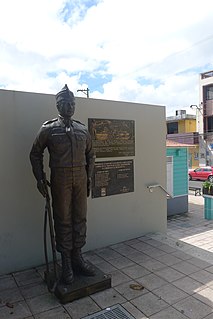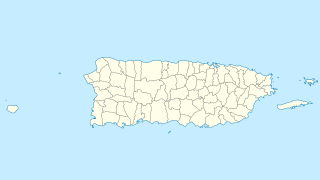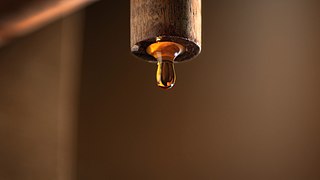
Puerto Rico, officially the Commonwealth of Puerto Rico and briefly called Porto Rico, is an unincorporated territory of the United States located in the northeast Caribbean Sea, approximately 1,000 miles (1,600 km) southeast of Miami, Florida.

San Juan is the capital and most populous municipality in the Commonwealth of Puerto Rico, an unincorporated territory of the United States. As of the 2010 census, it is the 46th-largest city under the jurisdiction of the United States, with a population of 395,326. San Juan was founded by Spanish colonists in 1521, who called it Ciudad de Puerto Rico. Puerto Rico's capital is the third oldest European-established capital city in the Americas, after Santo Domingo, in the Dominican Republic, founded in 1496 and Panama City, in Panama, founded in 1519. Several historical buildings are located in San Juan; among the most notable are the city's former defensive forts, Fort San Felipe del Morro and Fort San Cristóbal, and La Fortaleza, the oldest executive mansion in continuous use in the Americas.

Vieques, in full Isla de Vieques, is an island–municipality of Puerto Rico, United States in the northeastern Caribbean, part of an island grouping sometimes known as the Spanish Virgin Islands. Vieques is part of the Commonwealth of Puerto Rico, and retains strong influences from 400 years of Spanish presence in the island.

Isla Culebra is an island-municipality of Puerto Rico and geographically part of the Virgin Islands. It is located approximately 17 miles (27 km) east of the Puerto Rican mainland, 12 miles (19 km) west of St. Thomas and 9 miles (14 km) north of Vieques. Culebra is spread over 5 wards and Culebra Pueblo (Dewey), the downtown area and the administrative center of the city. Residents of the island are known as Culebrenses. With a population of 1,818 as of the latest census, it is Puerto Rico's least populous municipality.

Salinas is a municipality in the southern part of Puerto Rico (U.S.) located in the southern coast of the island, south of Aibonito and Cayey; southeast of Coamo, east of Santa Isabel; and west of Guayama. Salinas is spread over 5 wards and Salinas Pueblo.

Mayagüez is the eighth-largest municipality of Puerto Rico (U.S.). It was founded as Nuestra Señora de la Candelaria, and is also known as La Sultana del Oeste, Ciudad de las Aguas Puras, or Ciudad del Mangó. On April 6, 1894, the Spanish Crown gave it the formal title of Excelente Ciudad de Mayagüez. Mayagüez is located in the center of the western coast on the island of Puerto Rico. It is a principal city of the Mayagüez Metropolitan Statistical Area and the Mayagüez–San Germán–Cabo Rojo Combined Statistical Area.

Puerto Rican cuisine has its roots in the cooking traditions and practices of Europe, Africa and the native Taínos. Starting from the latter part of the 19th century, the cuisine of Puerto Rico has been greatly influenced by the United States in the ingredients used in its preparation. Puerto Rican cuisine can be found in several other countries.

Corozal is a municipality of Puerto Rico (U.S.) located in the central-eastern region, north of Orocovis and Barranquitas; south of Vega Alta; southwest of Toa Alta; east of Morovis and Orocovis; and west of Naranjito. Corozal is spread over 12 wards and Corozal Pueblo. It is part of the San Juan-Caguas-Guaynabo Metropolitan Statistical Area.

Guayanilla is a municipality of Puerto Rico (U.S.) located in southern coast of the island, bordering the Caribbean Sea, south of Adjuntas, east of Yauco; and west of Peñuelas and about 12 miles (19 km) west of Ponce. Guayanilla is spread over 16 wards and Guayanilla Pueblo. It is part of the Yauco Metropolitan Statistical Area.

Maricao is the second-least populous municipality of Puerto Rico (U.S.); it is located at the western edge of the Cordillera Central. It is a small town set around a small plaza in hilly terrain, north of San Germán, Sabana Grande and Yauco; south of Las Marías and Lares, southeast of Mayagüez, and west of Adjuntas. Maricao is spread over 15 wards and Maricao Pueblo.

Vega Baja is a municipality located on the coast of north central Puerto Rico (U.S.). It is north of Morovis, east of Manatí, and west of Vega Alta. Vega Baja is spread over 12 wards and Vega Baja Pueblo. It is part of the San Juan–Caguas–Guaynabo metropolitan statistical area.

Quebradillas is a municipality of the island of Puerto Rico (U.S.), located in the north-western shore bordering the Atlantic Ocean, north of San Sebastián; east of Isabela; and west of Camuy. Quebradillas is spread over seven wards and Quebradillas Pueblo. It is part of the San Juan-Caguas-Guaynabo Metropolitan Statistical Area.

The golden coquí is a rare and possibly extinct frog species endemic to Puerto Rico.

Desecheo is a small uninhabited island of the archipelago of Puerto Rico located in the northeast of the Mona Passage; 13 mi (21 km) from the west coast of the main island of Puerto Rico and 31 mi (50 km) northeast of Mona Island. It has a land area of 0.589 sq mi/376.74 acres. Politically, the island is administered by the U.S. Department of the Interior, U.S. Fish and Wildlife Service.

The fauna of Puerto Rico is similar to other island archipelago faunas, with high endemism, and low, skewed taxonomic diversity. Bats are the only extant native terrestrial mammals in Puerto Rico. All other terrestrial mammals in the area were introduced by humans, and include species such as cats, goats, sheep, the small Asian mongoose, and escaped monkeys. Marine mammals include dolphins, manatees, and whales. Of the 349 bird species, about 120 breed in the archipelago, and 47.5% are accidental or rare.

Flamenco Beach is a public beach on the Caribbean island of Culebra. It is known for its shallow turquoise waters, white sand, swimming areas, and diving sites. It stretches for a mile around a sheltered, horseshoe-shaped bay. Playa Flamenco is a popular beach destination for both Culebra and Puerto Rico. In March 2014, Flamenco beach was ranked 3rd best beach in the world with a TripAdvisor Travelers' Choice Award. In August 2016, it was announced that Flamenco Beach had regained its Blue Flag Beach international distinction.

The Taíno were an indigenous people of the Caribbean. At the time of European contact in the late fifteenth century, they were the principal inhabitants of most of Cuba, Hispaniola, Jamaica, Puerto Rico, The Bahamas and the northern Lesser Antilles. The Taíno were the first New World peoples to be encountered by Christopher Columbus during his 1492 voyage. They spoke the Taíno language, an Arawakan language.

The Puerto Rican broad-winged hawk is an endangered subspecies of the broad-winged hawk. It is a small hawk that occurs in Puerto Rico, inhabiting the Toro Negro State Forest. Its Spanish common name is guaragüao de bosque.



















